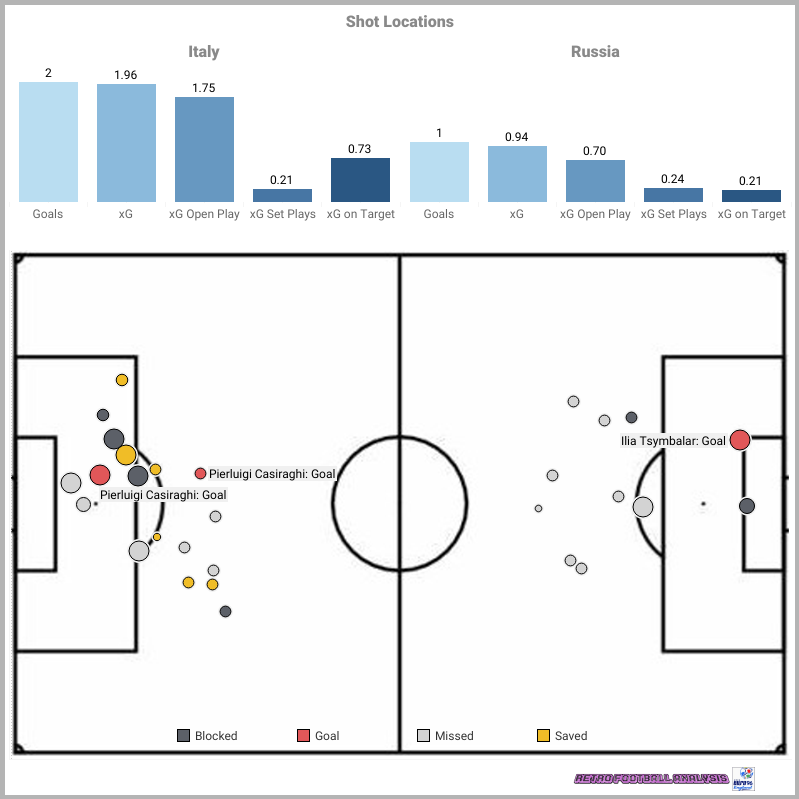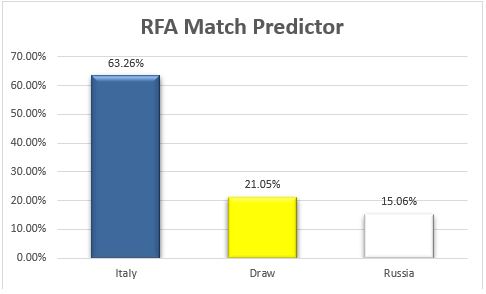Italy have a very clearly defined and aggressive 442 defensive structure that uses immediate forward pressure to pin the opponent back, but also maintains a very high defensive line should they beat the first line of pressure. These moments allow Italy to create attacks closer to the opposition goal should they force a turn over, and gives their forwards more numbers around the ball in which to create combinations during counter attacks.
When Italy build up play their attacking movements are far more fluid than the rigidity of their defensive shape, with full backs on either side are encouraged to attack the flanks with forward runs thus allowing them to create from wide areas as well as pull pressure away from their wingers. Both wingers are encouraged to move into central channels during build up & play between the lines like attacking midfielders. Wingers on the opposite side to the ball were also encouraged to make diagonal runs centrally to support the strikers, giving Italy three players inside the box to attack crosses at any given time.
Perhaps the most passive positions are the central midfielders Di Matteo & Albertini, both have fabulous technical ability but act as pivot points to switch the ball with the full backs and wingers tasked with more of the creative heavy lifting.
Italy Starting X1

Russia would set up in a deep lying 4-5-1 system, that in attack could morph into a more traditional 4-3-3. Russia favored a far more patient approach to their attack play, often overloading on the left to allow for a switch to the right for Kanchelskis to attack Maldini in a 1v1.
Kolyvanov is a classic hold up play/target man, but will also turn & advance himself with a shot on goal.
Mostovoi, Radimov & Karpin positioning is very fluid. With either one of them breaking forward to support the striker.
Tsimbalar is more of a central midfielder playing wide, which affords Kovtun the opportunity to get forward & support from wide areas.
Russia Starting X1

WHAT DO THE NUMBERS TELL US?

Value of Chances
xG Timeline:
Italy’s numbers are interesting. My first observation would be that they attacked very consistently throughout the match, but strangely in the 15 minutes that followed each of their goals they took their foot off the gas and didn’t register a single attack.
Despite all of Russia’s possession they really failed to impact the game from a chance creation perspective. The last 30 minutes of the match are a good reflection of this, given they were losing 2-1 and chasing the game yet were unable to make any impact in front of goal.
Chance Value:
While Italy did record lots of attacks, 18 overall, only seven of which would hit double digit xG. In isolation not every attack is going to be of the highest probability, however over the course of the game the lower the probability the less of an impact your attack play is having. Italy managed to hit their opponent when it mattered, but ultimately will be looking for more from their attackers in the next game in terms of efficiency.
Looking at Russia’s xG it would suggest that a one goal return is probably fair, however with only one attack all game on target (a shot that would see them score) it perhaps suggests there is quite a bit to think about ahead of the next two games.
Type of Chances Created

From the first whistle it was abundantly clear that Sacchi had set up Italy to hunt in packs & attack through transitions. This was evidenced in the data as Italy recorded 8 attacks on goal from counter attacks, 6 of which ended up on target and it returned two goals. Italy varied their key pass selection, with 3 of their through balls ending up with a shot on goal, but we also saw 4 short passes all set up a shot on target. The combination play Italy favor is an up, back and through or up back and shoot approach, when sees them advance up the field quickly and penetrate the central spaces.
With Russia’s attack play coming through a careful possession approach, so it comes as no surprise that 5 of their 11 attacks came through build up play, and the key pass to assist the attack came via a short pass on every occasion. Given the pace and dynamic qualities of Mostovoi and Kanchelskis they will be disappointed that they werent able to hurt Italy more on the counter attack, with all three of their counters failing to turn an attack on target.
Where Chances are Created

From Italy’s 18 attacks we saw an even 9 & 9 split between outside & inside of the box attacks, with a goal coming from each location. Interestingly though 5 of Italy’s attacks from outside of the box tested the goalkeeper, with only 3 doing so from inside the box. Italy will be happy that almost 90% of their xG was created through open play attacks, this obviously shows that they were able to break down their opponent consistently. Where they will have food for thought is in their xG on target, which came back at 0.73. This tells us that only 37% of their chance creation actually tested the keeper.
The Russian’s failed to penetrate the penalty box enough in this match, with only 3 of the 11 attacks entering the 18. Russia seemed adamant to continue to shoot from distance, despite showing little ability of being able to do so effectively. All 8 of their attempts from distance would miss the target completely.
Who Created Chances
Pierluigi Casiraghi was undoubtedly Italy’s most impressive statistical attacker, contributing to 6 attacks overall & scoring twice. He would return a personal xG of 0.88 in the match, which accounted for 44% of his teams overall attack play.
Russia’s best statistical attack was left midfielder Ilya Tsymbalar, who created two attacks during the game & provided Russia’s only goal of the match.
Match Predictor
Using our very own Retro Football Analysis Match Simulator, we use the probability rating of each attack to calculate the odds of the matches outcome. Here are the results we got back.

Our Verdict:
Italy out gunned Russia for much of this match, but it was undoubtedly their 2nd half performance which has swung the predictor in Italy’s favor. Russia for sure carry a threat, but they’ll need to get themselves closer to the box in order to showcase what their capable of.


